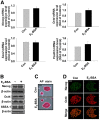Rapid actions of plasma membrane estrogen receptors regulate motility of mouse embryonic stem cells through a profilin-1/cofilin-1-directed kinase signaling pathway
- PMID: 22734041
- PMCID: PMC5416980
- DOI: 10.1210/me.2012-1002
Rapid actions of plasma membrane estrogen receptors regulate motility of mouse embryonic stem cells through a profilin-1/cofilin-1-directed kinase signaling pathway
Abstract
Long-term estrogen actions are vital for driving cell growth, but more recent evidence suggests that estrogen mediates more rapid cellular effects. However, the function of estradiol-17β (E(2))-BSA in mouse embryonic stem cells has not been reported. Therefore, we examined the role of E(2)-BSA in mouse embryonic stem cell motility and its related signal pathways. E(2)-BSA (10(-8) m) significantly increased motility after 24 h incubation and increased filamentous (F)-actin expression; these effects were inhibited by the estrogen receptor antagonist ICI 182,780, indicating that E(2)-BSA bound membrane estrogen receptors and initiated a signal. E(2)-BSA increased c-Src and focal adhesion kinase (FAK) phosphorylation, which was attenuated by ICI 182,780. The E(2)-BSA-induced increase in epidermal growth factor receptor (EGFR) phosphorylation was inhibited by Src inhibitor PP2. As a downstream signal molecule, E(2)-BSA activated cdc42 and increased formation of a complex with the neural Wiskott-Aldrich syndrome protein (N-WASP)/cdc42/transducer of cdc42-dependent actin assembly-1 (TOCA-1), which was inhibited by FAK small interfering RNA (siRNA) and EGFR inhibitor AG 1478. In addition, E(2)-BSA increased profilin-1 expression and cofilin-1 phosphorylation, which was blocked by cdc42 siRNA. Subsequently, E(2)-BSA induced an increase in F-actin expression, and cell motility was inhibited by each signal pathway-related siRNA molecule or inhibitors but not by cofilin-1 siRNA. A combined treatment of cofilin-1 siRNA and E(2)-BSA increased F-actin expression and cell motility more than that of E(2)-BSA alone. These data demonstrate that E(2)-BSA stimulated motility by interacting with profilin-1/cofilin-1 and F-actin through FAK- and c-Src/EGFR transactivation-dependent N-WASP/cdc42/TOCA-1 complex.
Figures







Similar articles
-
C(16)-Ceramide-induced F-actin regulation stimulates mouse embryonic stem cell migration: involvement of N-WASP/Cdc42/Arp2/3 complex and cofilin-1/α-actinin.Biochim Biophys Acta. 2013 Feb;1831(2):350-60. doi: 10.1016/j.bbalip.2012.09.005. Epub 2012 Sep 15. Biochim Biophys Acta. 2013. PMID: 22989773
-
Paxillin, a novel controller in the signaling of estrogen to FAK/N-WASP/Arp2/3 complex in breast cancer cells.Mol Cell Endocrinol. 2016 Jul 15;430:56-67. doi: 10.1016/j.mce.2016.04.007. Epub 2016 Apr 16. Mol Cell Endocrinol. 2016. PMID: 27095481
-
Estrogen receptor-alpha promotes breast cancer cell motility and invasion via focal adhesion kinase and N-WASP.Mol Endocrinol. 2010 Nov;24(11):2114-25. doi: 10.1210/me.2010-0252. Epub 2010 Sep 29. Mol Endocrinol. 2010. PMID: 20880986 Free PMC article.
-
Regulation of WASP: PIP2 Pipped by Toca-1?Cell. 2004 Jul 23;118(2):140-1. doi: 10.1016/j.cell.2004.07.005. Cell. 2004. PMID: 15260983 Review.
-
TM4SF5-mediated protein-protein networks and tumorigenic roles.BMB Rep. 2014 Sep;47(9):483-7. doi: 10.5483/bmbrep.2014.47.9.146. BMB Rep. 2014. PMID: 25027595 Free PMC article. Review.
Cited by
-
Localisation of oestrogen receptors in stem cells and in stem cell-derived neurons of the mouse.J Neuroendocrinol. 2023 Feb;35(2):e13220. doi: 10.1111/jne.13220. Epub 2022 Dec 12. J Neuroendocrinol. 2023. PMID: 36510342 Free PMC article.
-
Counteracting the Ramifications of UVB Irradiation and Photoaging with Swietenia macrophylla King Seed.Molecules. 2021 Apr 1;26(7):2000. doi: 10.3390/molecules26072000. Molecules. 2021. PMID: 33916053 Free PMC article.
-
Estrogen inhibits TGF‑β1‑stimulated cardiac fibroblast differentiation and collagen synthesis by promoting Cdc42.Mol Med Rep. 2024 Jul;30(1):123. doi: 10.3892/mmr.2024.13246. Epub 2024 May 24. Mol Med Rep. 2024. PMID: 38785153 Free PMC article.
-
Caveolin1: its roles in normal and cancer stem cells.J Cancer Res Clin Oncol. 2021 Dec;147(12):3459-3475. doi: 10.1007/s00432-021-03793-2. Epub 2021 Sep 8. J Cancer Res Clin Oncol. 2021. PMID: 34498146 Free PMC article. Review.
-
Increased intracellular pH is necessary for adult epithelial and embryonic stem cell differentiation.J Cell Biol. 2016 Nov 7;215(3):345-355. doi: 10.1083/jcb.201606042. J Cell Biol. 2016. PMID: 27821494 Free PMC article.
References
-
- Park JH , Lee MY , Han HJ. 2009. A potential role for caveolin-1 in estradiol-17β-induced proliferation of mouse embryonic stem cells: involvement of Src, PI3K/Akt, and MAPKs pathways. Int J Biochem Cell Biol 41:659–665 - PubMed
-
- Yun SP , Lee MY , Ryu JM , Song CH , Han HJ. 2009. Role of HIF-1α and VEGF in human mesenchymal stem cell proliferation by 17β-estradiol: involvement of PKC, PI3K/Akt, and MAPKs. Am J Physiol Cell Physiol 296:C317–C326 - PubMed
-
- Zhou S , Zilberman Y , Wassermann K , Bain SD , Sadovsky Y , Gazit D. 2001. Estrogen modulates estrogen receptor α and β expression, osteogenic activity, and apoptosis in mesenchymal stem cells (MSCs) of osteoporotic mice. J Cell Biochem Suppl 36:144–155 - PubMed
-
- Björnström L , Sjöberg M. 2005. Mechanisms of estrogen receptor signaling: convergence of genomic and nongenomic actions on target genes. Mol Endocrinol 19:833–842 - PubMed
-
- Keung W , Chan ML , Ho EY , Vanhoutte PM , Man RY. 2011. Non-genomic activation of adenylyl cyclase and protein kinase G by 17β-estradiol in vascular smooth muscle of the rat superior mesenteric artery. Pharmacol Res 64:509–516 - PubMed
Publication types
MeSH terms
Substances
LinkOut - more resources
Full Text Sources
Research Materials
Miscellaneous

